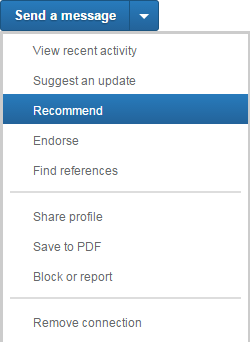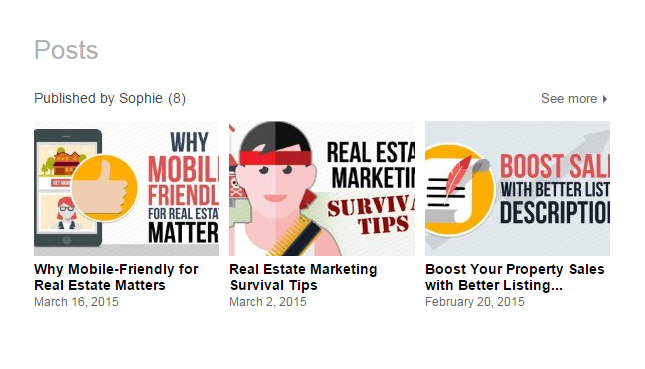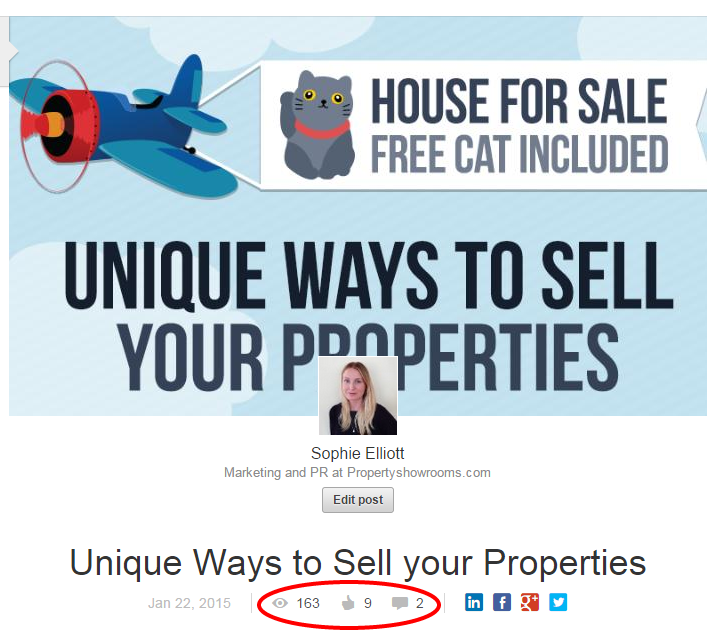Getting Down to Business with LinkedIn
With more than 300 million users across 200 countries, LinkedIn has changed the way real estate professionals are able to build relationships and do business online. Initially viewed as a sort of online CV, LinkedIn is now the top social network for business professionals to connect, network and engage with each other, which is why it’s top of the list for my recommended social networks for real estate professionals.
Step 1: Optimize your Profile
Your LinkedIn profile should be compelling, clear and complete so that potential clients, recruits or business relationships can quickly recognize your particular area of expertise. Make sure you include a good a summary, introducing yourself, your business and why you’re a good choice of realtor (both to buy from and to sell through). It’s a good idea to address your prospects problems and highlight your strengths when explaining what you do, this will give buyers and investors an immediate reason to choose you from the get go. Try something like “If you’re looking for an agent to (insert prospect problems) I can provide (your strengths).”
Just like you do with your website and blogs, your profile and Company Page should include key words, enabling those interested in what you have to offer to find and connect with you. Use words that are specific to your niche and geographical location to push your profile to the top of search results. For example, if you do residential listings in Malaga, Spain, make sure those words are included on your profile.
In addition to this you can also change your standard LinkedIn URL to a link containing your name. This will make it easier for clients and fellow real estate agents to find and identify you. We suggest making your URL a combination of your name and a keyword related to your business or your role within that business. Why? Because most of the time, you’ll find your full name will be unavailable. Therefore by coupling it with “realtor” or “real-estate-agent” you can maximize your visibility amongst prospects and peers in LinkedIn and Google searches.
Step 2: Connect with everyone
Growing your connections on LinkedIn is a great way to broaden your sphere of influence and the more connections you have the better. Unlike other networks, LinkedIn makes it hard for you to see a person’s profile or posts if you aren’t at least a 2nd or 3rd degree connection with them. Meaning the more connections you have, the more people can find you and learn about what you do.
There is not a rule that you are only allowed to connect with people that you know on LinkedIn, that’s simply not the case. It’s ok to send requests to people you haven’t met as long as you explain who you are, what you do and why you want to connect in the invitation. Search for users in your area, other agents, home appraisers, mortgage brokers, and anyone else you think might be of interest to your real estate business. Remember, the same rule applies for online as offline and in both cases there’s no such thing as too big a network. You never know where each connection will lead you and you can’t find out unless you ask.
Step 3: Ask for Recommendations
One of the most powerful tools available on LinkedIn is recommendations.
Having recommendations showcase your skills, first hand client satisfaction, and solidifies your online credibility. To obtain recommendations from your LinkedIn connections, try sending recommendation requests to clients and business professionals. Or better yet, start by making recommendations for others, chances are they’ll return the favor.

You can make a recommendation for anyone whose work you’d like to recognize like a colleague, co-worker, student or peer on LinkedIn.
There are several different ways you can make a recommendation including:
- Recommend someone from their profile
- Recommend someone from the Recommendations page
- Respond to a recommendation request in your LinkedIn inbox
- Recommend someone from a recommendation request sent to your email address
To find out how to go about making one of the above recommendations go to the LinkedIn Help Center – this is also a great place to direct clients when you ask for a recommendation.
Step 4: Share content
Sharing content is a great way to find and connect with people who share similar interests, and not just peers but prospects too.
When you’re deciding which content to share on LinkedIn, always aim to help others, but make sure the type of information you provide varies. For example one day you might choose to post an informative article on a new development taking place in the in real estate industry, and on the next, you might choose to share an opinionated blog post on what agents are doing wrong and how they might improve.
But remember, you can’t post content up on LinkedIn and expect people to find it. Take time to read content from other thought leaders and influencers. Follow them, comment on their posts, and invite them to comment on yours. You get out what you put in when it comes to content interaction.
As an added bonus, you’re likely to learn from those you follow. Their thoughts will inspire and help shape your opinions, which in turn will likely lead to fuller, more interesting blog posts from you.
Step 5: Publish directly on LinkedIn Pulse
As well as sharing and commenting on other peoples content you should also ideally be writing your own. Why? Because the more knowledgeable prospective customers feel you are the more likely they will be to choose you as their agent.

One of the latest developments to make LinkedIn unique is that it allows you to publish your content for all of LinkedIn to see, using a publishing platform it calls Pulse. The network refers to them as long-form posts, and they’re definitely worth checking out. Why? Because the posts appear on your profile and publishing your own content only adds to your credibility. In addition the posts are searchable both on and off LinkedIn, meaning users do not have to be in your network to view them, and people are able to connect with you directly from your posts. That alone makes this an invaluable tool for building your network and establishing your expertise in the real estate industry on LinkedIn.
Step 6: Be active in groups
Groups are a great way to showcase your expertise by contributing to discussions. They’re also a great place to find prospects, buyers and investors often turn to groups on LinkedIn to voice any questions or concerns they have about a purchase they’re considering.
The aim of the game when it comes to groups is to find relevant groups and add value to them. How? Respond to others’ questions, give your opinions, share advice, and ask thought provoking questions. And do not promote your business or post links to your site unless it is relevant and you think doing so would add value to conversation. Even better why not start your own group, and invite prospects and peers to take part in the discussion you create, this again will reinforce your expertise in real estate.
Step 7: Study analytics
LinkedIn doesn’t necessarily have an insights dashboard like Facebook, but you can still use the information that is provided to your advantage. One of the metrics you can look at is which of your posts received interactions (and how many) and which ones didn’t. My advice is to study these analytics and use them to understand what people in your network like in order to know what to post or share, and in turn avoid the stuff that isn’t received well. Remember your content should address your prospects and if you know what they respond well to you have more chance of reaching more and more of them.

Step 8: Help others
Finally, take a few minutes each day to endorse and recommend other people, just like content sharing this again is a case of the more you do the more you get in return. The likelihood is that those you promote will appreciate the gesture and return the favor.
Final Note
Whilst LinkedIn was initially a platform designed for business to business communication it has evolved into a great place to meet and interact with prospects. In fact a study carried out by the network last year found seven out of ten consumer marketers now use LinkedIn to distribute content, including brands like Mercedes-Benz, Fruit of the Loom and Delta Air Lines.
What’s more, according to comScore’s 2013 Buying Power Index, LinkedIn members have nearly 2x more buying power than Facebook.
In addition there are a number of groups dedicated to property investment and users looking to buy will likely turn to the more professionally orientated social networks like LinkedIn to select the agent they feel are best suited for the job.
So there you have it, the best ways to use LinkedIn as a real estate professional to obtain meaningful results.
Do you have any tips for successfully using LinkedIn? Let us know in the comments below.








